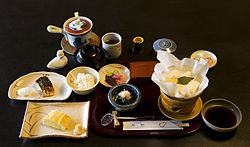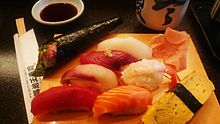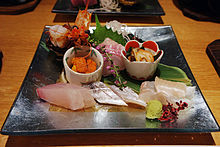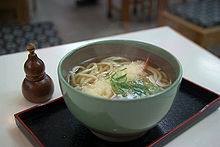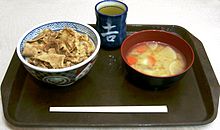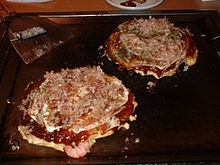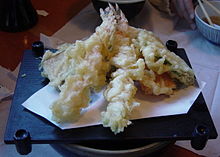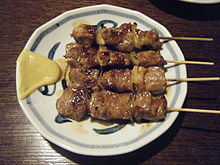- Japanese cuisine
-

This article is part of the series Japanese cuisine
日本料理Regional cuisinesIngredientsBento • Main dishes • Desserts • Noodles • Sashimi • Sushi
Preparation and cookingUtensilsRituals & FestivalsEtiquette • Kaiseki • Japanese New Year
 Japan portal
Japan portalJapanese cuisine has developed over the centuries as a result of many political and social changes throughout Japan. The cuisine eventually changed with the advent of the Medieval age which ushered in a shedding of elitism with the age of shogun rule. In the early modern era significant changes occurred resulting in the introduction of non-Japanese cultures, most notably Western culture, to Japan.
The modern term "Japanese cuisine" (nihon ryōri (日本料理?) or washoku (和食?)) means traditional-style Japanese food, similar to that already existing before the end of national seclusion in 1868. In a broader sense of the word, it could also include foods whose ingredients or cooking methods were subsequently introduced from abroad, but which have been developed by Japanese people who have made these methods their own. Japanese cuisine is known for its emphasis on seasonality of food (旬, shun),[1] quality of ingredients and presentation. The Michelin Guide has awarded Japanese cities by far the most Michelin stars of any country in the world (for example, Tokyo alone has more Michelin stars than Paris, Hong Kong, New York, LA and London combined).[2][3]
History
Ancient era - Heian period
Following the Jōmon period, Japanese society shifted from semi-sedentary hunter-gatherer lifestyle to an agricultural society. This was the period in which rice cultivation began, having been introduced by China.[4] Rice was commonly boiled plain and called gohan or meshi, and, as cooked rice has since always been the preferred staple of the meal, the terms are used as synonyms for the word "meal". Peasants often mixed millet with rice, especially in mountainous regions where rice did not proliferate.[5]
During the Kofun period, Chinese culture was introduced into Japan from the Korean Peninsula. As such, Buddhism became influential on Japanese culture. After the sixth century, Japan directly pursued the imitation of Chinese culture of the Tang dynasty.[6] It was this influence that marked the taboos on the consumption of meat in Japan. In 675 AD, Emperor Temmu decreed a prohibition on the consumption of cattle, horses, dogs, monkeys, and chickens during the 4th-9th months of the year; to break the law would mean a death sentence. Monkey was eaten prior to this time, but was eaten more in a ritualistic style for medicinal purposes. Chickens were often domesticated as pets,[citation needed] while cattle and horses were rare and treated as such. A cow or horse would be ritually sacrificed on the first day of rice paddy cultivation, a ritual introduced from China. Emperor Temmu's decree, however, did not ban the consumption of deer or wild boar, which were important to the Japanese diet at that time.[7]
The eighth century saw many additional decrees made by emperors and empresses banning the killing of any animals. In 752 AD, Empress Kōken decreed a ban on fishing, but made a promise that adequate rice would be given to fishermen whose livelihood would have otherwise been destroyed. In 927 AD, regulations were enacted that stated that any government official or member of nobility that ate meat was deemed unclean for three days and could not participate in Shinto observances at the imperial court.[8]
It was also the influence of Chinese cultures that brought chopsticks to Japan early in this period.[9][10][11][12][13] Chopsticks at this time were used by nobility at banquets; they were not used as everyday utensils however, as hands were still commonly used to eat. Metal spoons were also used during the 8th-9th century, but only by the nobility.[14] Dining tables were also introduced to Japan at this time. Commoners used a legless table called a oshiki, while nobility used a lacquered table with legs called a zen. Each person used his own table. Lavish banquets for the nobility would have multiple tables for each individual based upon the number of dishes presented.[15]
Upon the decline of the Tang dynasty in the ninth century, Japan made a move toward its individuality in culture and cuisine. The abandonment of the spoon as a dining utensil – which was retained in Korea – is one of the marked differences, and commoners were now eating with chopsticks as well. Trade continued with China and Korea, but influence en masse from outside of Japan would not be seen again until the 19th century. The 10th and 11th centuries marked a level of refinement of cooking and etiquette found in the culture of the Heian nobility. Court chefs would prepare many of the vegetables sent as tax from the countryside. Court banquets were common and lavish; garb for nobility during these events remained in the Chinese style which differentiated them from the plain clothes of commoners.[16]
The dishes consumed after the 9th century included grilled fish and meat (yakimono), simmered food (nimono), steamed foods (mushimono), soups made from chopped vegetables, fish or meat (atsumono), jellied fish (nikogori) simmered with seasonings, sliced raw fish served in a vinegar sauce (namasu), vegetables, seaweed or fish in a strong dressing (aemono), and pickled vegetables (tsukemono) that were cured in salt to cause lactic fermentation. Oil and fat were avoided almost universally in cooking. Sesame oil was used, but rarely, as it was of great expense to produce.[17]
Documents from the Heian nobility note that fish and wild fowl were common fare along with vegetables. Their banquet settings consisted of a bowl of rice and soup, along with chopsticks, a spoon, and three seasonings which were salt, vinegar and hishio, which was a fermentation of soybeans, wheat, sake and salt. A fourth plate was present for mixing the seasonings to desired flavor for dipping the food. The four types of food present at a banquet consisted of dried foods (himono), fresh foods (namamono), fermented or dressed food (kubotsuki), and desserts (kashi). Dried fish and fowl were thinly sliced (e.g. salted salmon, pheasant, steamed and dried abalone, dried and grilled octopus), while fresh fish, shellfish and fowl were sliced raw in vinegar sauce or grilled (e.g. carp, sea bream, salmon, trout, pheasant). Kubotsuki consisted of small balls of fermented sea squirt, fish or giblets along with jellyfish and aemono. Desserts would have included Chinese cakes, and a variety of fruits and nuts including pine nuts, dried chestnuts, acorns, jujube, pomegranate, peach, apricot, persimmon and citrus. The meal would be ended with sake.[18]
Kamakura period
The Kamakura period marked a large political change in Japan. Prior to the Kamakura period, the samurai were guards of the landed estates of the nobility. The nobility, having lost control of the Japanese countryside, fell under the militaristic rule of the peasant class samurai, with a military government being set up in 1192 in Kamakura giving way to the period. Once the position of power had been exchanged, the role of the court banquets changed. The court cuisine which had prior to this time emphasized flavor and nutritional aspects changed to a highly ceremonial and official role.[19]
Minamoto Yoritomo, the first shogun, punished other samurai who followed the earlier showy banquet style of the nobility. The shogun banquet, called ōban, was attended by military leaders from the provinces. The ōban originally referred to a luncheon on festival days attended by soldiers and guards during the Heian period, and was attached to the warrior class. The menu usually consisted of dried abalone, jellyfish aemono, pickled ume called umeboshi, salt and vinegar for seasoning, and rice. Later in the period, the honzen ryōri banquet became popularized.[20]
The cuisine of the samurai came distinctly from their peasant roots. The meals prepared emphasized simplicity while being substantial. The cuisine avoided refinement, ceremony and luxury, and shed all further Chinese influence. One specific example is the change from wearing traditional Chinese garb to a distinct clothing style that combined the simple clothing of the common people. This style evolved into the kimono by the end of the Middle Ages.[21]
The Buddhist vegetarian philosophy strengthened during the Kamakura period as it began to spread to the peasants. Those who were involved in the trade of slaughtering animals for food or leather came under discrimination. Those practicing this trade were considered in opposition to the Buddhist philosophy of not taking life, while under the Shinto philosophy they were considered defiled. This discrimination intensified, and eventually led to the creation of a separate caste, the burakumin.[22]
Modern era
Japanese cuisine is based on combining staple foods, typically rice or noodles, with a soup and okazu (おかず) — dishes made from fish, meat, vegetable, tofu and the like — to add flavor to the staple food. These are typically flavored with dashi, miso, and soy sauce and are usually low in fat and high in salt.
A standard Japanese meal generally consists of several different okazu accompanying a bowl of cooked white Japanese rice (gohan, 御飯), a bowl of soup and some tsukemono (pickles).
The most standard meal comprises three okazu and is termed ichijū-sansai (一汁三菜; "one soup, three sides"). Different cooking techniques are applied to each of the three okazu; they may be raw (sashimi), grilled, simmered (sometimes called boiled), steamed, deep-fried, vinegared, or dressed. This Japanese view of a meal is reflected in the organization of Japanese cookbooks: Chapters are devoted to cooking techniques as opposed to ingredients. There may also be chapters devoted to soups, sushi, rice, noodles, and sweets.
As Japan is an island nation, its people eat a lot of seafood. Meat-eating has been rare until fairly recently due to restrictions of Buddhism.[citation needed] However, strictly vegetarian food is rare since even vegetable dishes are flavored with the ubiquitous dashi stock, usually made with katsuobushi (dried skipjack tuna flakes). An exception is shōjin ryōri (精進料理), vegetarian dishes developed by Buddhist monks. However, the advertised shōjin ryōri at public eating places includes some non-vegetarian elements.
Noodles are an essential part of Japanese cuisine usually as an alternative to a rice-based meal. Soba (thin, grayish-brown noodles containing buckwheat flour) and udon (thick wheat noodles) are the main traditional noodles and are served hot or cold with soy-dashi flavorings. Chinese-style wheat noodles served in a meat stock broth known as ramen have become extremely popular over the last century.
Vegetable consumption has dwindled while processed foods have become more prominent in Japanese households due to the rising costs of general foodstuffs.[23]
Staple foods (Shushoku)
There are many staple foods that are considered part of Japan's national cuisine today. Below are listed some of the most common.
- Since its cultivation in Japan about 2000 years ago, rice has been Japan's most important crop. Its fundamental importance to the country and its culture is reflected by the facts that rice was once used as a currency, and that the Japanese word for cooked rice gohan (御飯) or meshi (飯) also has the general meaning of "meal". The literal meaning of breakfast (asagohan), for example, is "morning rice".
- Japanese rice is short grain and becomes sticky when cooked. Most rice is sold as hakumai ("white rice"), with the outer portion of the grains (nuka) polished away. Unpolished rice (genmai) is considered less delicious by most people, but its popularity has been increasing recently because gemmai is more nutritious and healthier than hakumai.
- A second major rice variety used in Japan is mochi rice. Cooked mochi rice is more sticky than conventional Japanese rice, and it is commonly used for sekihan (cooked mochi rice with red beans), or for pounding into rice cakes.
- Rice is processed and prepared in many different ways. Some popular processed rice products are listed below, while a list of popular ways to use rice can be found here. okayu, sake, wagashi, senbei, mochi, donburi (どんぶり, "bowl") and sushi.[24]
- Noodles often take the place of rice in a meal. They are featured in many soup dishes, or served chilled with a sauce for dipping.
- Bread/Pan is not native to Japan and is not considered traditional Japanese food, but since its introduction in the 19th century it has become common. The word pan is a loanword originally taken from Portuguese.
Main dishes
There are many dishes that are considered part of Japan's national cuisine today. Below are listed some of the most common.
- Grilled and pan-fried dishes (yakimono (焼き物)), stewed/simmered dishes (nimono (煮物)), stir-fried dishes (itamemono (炒め物)), steamed dishes (mushimono (蒸し物)), deep-fried dishes (agemono (揚げ物)), sashimi, soups (suimono (吸い物) and shirumono (汁物)), pickled, salted, and dressed foods (tsukemono (漬け物), aemono (和え物), sunomono (酢の物)), chinmi
Sweets and Snacks
- Japanese-style sweets (wagashi, 和菓子), old-fashioned Japanese-style sweets (dagashi, 駄菓子), Western-style sweets (yōgashi, 洋菓子), sweets bread (kashi pan, 菓子パン)
Beverages
Sake and shōchū
Sake is a rice wine that typically contains 12%~20% alcohol and is made by multiple fermentation of rice. At traditional meals, it is considered an equivalent to rice and is not simultaneously taken with other rice-based dishes. Side dishes for sake are particularly called sakana or otsumami.
Shōchū is a spirit most commonly distilled from barley, sweet potato, or rice. Shōchū is produced everywhere in Japan. Its production in Japan started in Kyūshū.[25]
Flavorings
Imported and adapted foods
Japan has incorporated imported food from across the world (mostly from Asia, Europe and to a lesser extent the Americas), and have historically adapted many to make them their own.
Yōshoku
Japan today abounds with home-grown, loosely western-style food. Many of these were invented in the wake of the 1868 Meiji restoration and the end of national seclusion, when the sudden influx of foreign (in particular, western) culture led to many restaurants serving western food, known as yōshoku (洋食), a shortened form of seiyōshoku (西洋食) lit. Western cuisine, opening up in cities. Restaurants that serve these foods are called yōshokuya (洋食屋), lit. Western cuisine restaurants.
Many yōshoku items from that time have been adapted to a degree that they are now considered Japanese and are an integral part of any Japanese family menu. Many are served alongside rice and miso soup, and eaten with chopsticks. Yet, due to their origins these are still categorized as yōshoku as opposed to the more traditional washoku (和食), lit. Japanese cuisine.
Regional cuisine
Japanese cuisine offers a vast array of regional specialties known as kyōdo ryōri (郷土料理), many of them originating from dishes prepared using traditional recipes with local ingredients. Mainly, there are Kanto region food and Kansai region food. Kanto region foods taste very strong. For example the dashi-based broth for serving udon noodles is heavy on dark soy sauce, similar to soba broth. On the other hand Kansai region foods are lightly seasoned, with clear udon noodles made with light soy sauce.[26]
While "local" ingredients are now available nationwide, and some originally regional dishes such as okonomiyaki and Edo-style sushi have spread throughout Japan and is no longer considered as such, many regional specialties survive to this day, with some new ones still being created.
Ingredients
- See also: List of Japanese ingredients, Category:Japanese ingredients
The following is a list of ingredients found in Japanese cuisine:
Many types of seafood are part of Japanese cuisine. Only the most common are in the list below. Includes freshwater varieties:
- Crab (kani)
- Roe
- Processed seafood
- Seaweed
Traditional table settings
The traditional Japanese table setting has varied considerably over the centuries, depending primarily on the type of table common during a given era. Before the 19th century, small individual box tables (hadoken, 箱膳) or flat floor trays were set before each diner. Larger low tables (chabudai, ちゃぶ台) that accommodated entire families were gaining popularity by the beginning of the 20th century, but these gave way to western style dining tables and chairs by the end of the 20th century.
Traditional Japanese table setting is to place a bowl of rice on your left and to place a bowl of miso soup on your right side at the table. Behind these, each okazu is served on its own individual plate. Based on the standard three okazu formula, behind the rice and soup are three flat plates to hold the three okazu; one to far back left, one at far back right, and one in the center. Pickled vegetables are often served on the side but are not counted as part of the three okazu. Chopsticks are generally placed at the very front of the tray near the diner with pointed ends facing left and supported by a chopstick rest, or hashioki.[26]
Dining etiquette
See also: Japanese etiquette#Eating and drinkingIt is customary to say itadakimasu, いただきます (literally "I [humbly] receive") before starting to eat a meal, and gochisōsama deshita, ごちそうさまでした (literally "It was a feast") to the host after the meal and the restaurant staff when leaving.
- Hot towel
- Before eating, most dining places will provide either a hot towel or a plastic-wrapped wet napkin (an oshibori). This is for cleaning hands before eating (and not after). It is rude to use them to wash the face or any part of the body other than the hands.[citation needed]
- Bowls
- The rice or the soup is eaten by picking up the bowl with the left hand and using chopsticks with the right, or vice versa if you are left-handed. Traditionally, chopsticks were held in the right hand and the bowl in the left – in fact, Japanese children were taught to distinguish left from right as "the right hand holds the chopsticks, the left hand holds the bowl" – but left-handed eating is acceptable today. Bowls may be lifted to the mouth, but should not be touched by the mouth except when drinking soup.
- Soy sauce
- Soy sauce is not usually poured over most foods at the table; a dipping dish is usually provided. Soy sauce is, however, meant to be poured directly onto tofu and grated daikon dishes, and in the raw egg when preparing tamago kake gohan ("egg on rice"). In particular, soy sauce should never be poured onto rice or soup. It's considered rude to waste soy sauce so moderation should be used when pouring into dishes.
- Chopsticks
- Chopsticks are never left sticking vertically into rice, as this resembles incense sticks (which are usually placed vertically in sand) during offerings to the dead. Using chopsticks to spear food or to point is frowned upon. It is very bad manners to bite chopsticks.
- Communal dish
- When taking food from a communal dish, unless they are family or very close friends, one should turn the chopsticks around to grab the food; it is considered more sanitary. Alternatively, one could have a separate set of chopsticks for communal dishes.
- Sharing
- If sharing food with someone else, move it directly from one plate to another. Never pass food from one pair of chopsticks to another, as this recalls passing bones during a funeral.
- Eat what is given
- It is customary to eat rice to the last grain. Being a picky eater is frowned on, and it is not customary to ask for special requests or substitutions at restaurants. It is considered ungrateful to make these requests especially in circumstances where you are being hosted, as in a business dinner environment. Good manners dictate that you respect the selections of the host.
- Drinking
- Even in informal situations, drinking alcohol starts with a toast (kanpai, 乾杯) when everyone is ready. It is not customary to pour oneself a drink; rather, people are expected to keep each other's drinks topped up. When someone moves to pour your drink you should hold your glass with both hands and thank them.
Dishes for special occasions
In Japanese tradition some dishes are strongly tied to a festival or event. These dishes include:
- Botamochi, a sticky rice dumpling with sweet azuki paste served in spring, while the term Hagi/Ohagi is used in autumn.
- Chimaki (steamed sweet rice cake): Tango no Sekku and Gion Festival.
- Hamo (a type of fish, often eel)[27] and somen: Gion Festival.
- Osechi: New Year.
- Sekihan, literally "red rice", is served for any celebratory occasion. It is usually sticky rice cooked with azuki, or red bean, which gives the rice its distinctive red color.[28]
- Soba:[29] New Year's Eve. This is called toshi koshi soba (ja:年越しそば) (literally "year crossing soba").
- Chirashizushi, Ushiojiru (clear soup of clams) and amazake: Hinamatsuri.
In some regions every 1st and 15th day of the month people eat a mixture of rice and azuki (azuki meshi (小豆飯), see Sekihan).
Foreign food
Foods from other countries vary in their authenticity. In Tokyo, it is quite easy to find restaurants serving authentic foreign cuisine. However, in most of the country, in many ways, the variety of imported food is limited; for example, it is rare to find pasta that is not of the spaghetti or macaroni varieties in supermarkets or restaurants; bread is very rarely of any variety but white; and varieties of imported breakfast cereals are limited to flakes or granola.
Japanese rice is usually used instead of imported rice (in dishes from Thailand, India, Italy, etc.) or including it in as a side dish to dishes that do not usually feature it, such as steak or omelets.
Chinese food is the most popular foreign cuisine throughout Japan. It is closely followed by Korean barbecue and Italian pasta.[30]
"Italian" restaurants tend to only have pizza and pasta on their menus. The cheaper Italian places in Japan tend to serve more Americanized versions of Italian foods, which often vary wildly from the versions found in Italy or in other countries. For pizza delivery, Pizza Hut and Domino's can easily be found in major cities, although the menus are localized. Corn, mayonnaise, and seafood toppings are popular. In sit-down restaurants, the vast majority of pizzas have crusts that are thinner and crispier, and have far less cheese and other toppings than in the U.S.
Many Italian dishes are changed, however high-class Japanese chefs have preserved many Italian seafood dishes that are forgotten in other countries. These include pasta with prawns, lobster (a specialty known in Italy as pasta all'aragosta), crab (an Italian specialty; in Japan it is served with a different species of crab), and pasta with sea urchin sauce (sea urchin pasta being a specialty of the Puglia region).
Hamburger chains include McDonald's, Burger King, First Kitchen, Lotteria and MOS Burger. Many chains developed uniquely Japanese versions of American fast food such as the teriyaki burger, kinpira rice burger, fried shrimp burgers, and green tea milkshakes.
Curry, which was originally imported from India into Japan by the British in the Meiji era, was first adopted by the Imperial Japanese Army, eventually leading to its presence in Japanese cuisine. Japanese curry is unlike Indian or any other forms of curry. Unique Japanese ingredients include apples and honey. Even Japanese curry branded as Indian curry is quite different. For instance, some Japanese "Indian-style" curries contain beef and pork, making them unacceptable to most Hindus, Jains, Jews and Muslims. Japanese versions of curry powder and sauces can be found in many foods, among them curry udon, curry bread, and curry tonkatsu.
Cuisine outside Japan
Many countries have imported portions of Japanese cuisine. Some may adhere to the traditional preparations of the cuisines, but in some cultures the dishes have been adapted to fit the palate of the local populace.
In Canada, Japanese cuisine has become quite popular in all medium and major cities, so that it is very unusual not to find one or more Japanese restaurants in cities above 100,000 population. Sushi, sashimi, and instant ramen are highly popular at opposite ends of the income scale, with instant ramen being a common low-budget meal. Sushi and sashimi takeout began in Toronto and Vancouver, but is now common throughout Canada. The largest supermarket chains all carry basic sushi and sashimi, and Japanese ingredients and instant ramen are readily available in most supermarkets. Most mid-sized mall food courts feature fast-food teppan cooking. Izakaya restaurants have gained a surge of popularity.
Japanese cuisine is an integral part of food culture in Hawaii as well as in other parts of the United States. Popular items are sushi, sashimi and teriyaki. Kamaboko, known locally as fish cake, is a staple of saimin, a noodle soup invented in and extremely popular in the state. Sushi, long regarded as quite exotic in the west until the 1970s, has become a popular health food in parts of North America, Western Europe and Asia.
In Mexico, certain Japanese restaurants have created what is known as "Sushi Mexicano", in which spicy sauces and ingredients accompany the dish or are integrated in sushi rolls. The habanero and serrano chiles have become nearly standard and are referred to as chiles toreados, as they are fried, diced and tossed over a dish upon request. A popular sushi topping, "Tampico", is made by blending chiles, mayonnaise, and crab imitation. Cream cheese and avocado is usually added to makizushi. Kamaboko is popular street food in South Korea, where it is known as eomuk (어묵) or odeng (오뎅). It is usually boiled on a skewer in broth and sold from street restaurant carts where they can be eaten with alcoholic beverage, especially soju. In the winter, deep-fried eomuk-on-a-stick (known alternatively as "hot-bar") is a popular treat.
Taiwan has adapted many Japanese food items. Taiwanese versions of tempura, only barely resembling the original, is known as 天婦羅 or 甜不辣 (tianbula) and is a famous staple in night markets in northern Taiwan. Taiwanese versions of oden is known locally as oren (黑輪) or 關東煮 Kwantung stew, after the Kansai area.
Ramen, of Chinese origin, has been exported back to China in recent years where it is known as ri shi la mian (日式拉麵, "Japanese lamian"). Popular Japanese ramen chains serve ramen alongside distinctly Japanese dishes such as tempura and yakitori, something which would be seen as odd in Japan. Ramen has gained popularity elsewhere in part due to the success of the Wagamama chain, although they are quite different from Japanese ramen. Instant ramen, invented in 1958, has now spread throughout the world. Skewered versions of oden is a common convenience store item in Shanghai where it is known as aódiǎn (熬点).
In Australia, sushi is considered a very popular lunch/snack option with one or two sushi bars in every shopping center. It would be hard to find a metropolitan area where it is not available, with some major supermarkets stocking pre-packaged options. There are also many casual 'food court' restaurants that cook fast food such as soft shell crab udon, tempura, and many other dishes. Also found are a great variety of 'sushi train' restaurants for a fun dining experience. In the city and surrounding suburbs there are many Japanese restaurants for formal dining.
In Brazil, Japanese food is widespread due to the large Japanese-Brazilian population living in the country, which represents the largest Japanese community living outside Japan. Over the past years, many restaurant chains such as Koni Store[31] have opened, selling typical dishes such as the popular temaki. Brazilians are particularly fond of yakisoba, which is readily available in all supermarkets, and often included in non-Japanese restaurant menus.
See also
References
- ^ "A Day in the Life: Seasonal Foods", The Japan Forum Newsletter No.14 September 1999.
- ^ (Japanese) "「ミシュランガイド東京・横浜・鎌倉2011」を発行 三つ星が14軒、二つ星が54軒、一つ星が198軒に", Michelin Japan, November 24, 2010.
- ^ Tokyo is Michelin's biggest star From The Times November 20, 2007
- ^ "Road of rice plant". National Science Museum of Japan. http://www.kahaku.go.jp/special/past/japanese/ipix/5/5-25.html. Retrieved 2011-03-24.
- ^ Kiple, 1176.
- ^ Ishige, 46-48.
- ^ Ishige, 53-54.
- ^ Ishige, 55-56.
- ^ Ishige, 67 "chopsticks originated in ancient China, spreading from the Yeelow River basin, which was then the center of Chinese civilization, to surrounding regions from about fifth century BCE."
- ^ The International Institute of Hashi
- ^ Osaka Kyoiku University 箸の伝来 "Transmission of chopsticks"
- ^ University of Marketing and Distribution Sciences Mori Takayuki (professor of Department of Commercial Science)
- ^ Komazawa Women's University "箸と日本人 (Chopsticks and Japanese)
- ^ Ishige, 67-69.
- ^ Ishige, 71
- ^ Ishige, 50-51.
- ^ Ishige, 71-72.
- ^ Ishige, 73-74.
- ^ Ishige, 51.
- ^ Ishige, 74-75.
- ^ Ishige, 51-52.
- ^ Ishige, 58.
- ^ Pulvers, Roger (2011-03-06). "Japanese families' nutritional values pay dearly for 'progress'". The Japan Times. http://search.japantimes.co.jp/rss/fl20110306rp.html. Retrieved 2011-03-22.
- ^ Japanese rice, retrieved January 8, 2010
- ^ "What is Shochu?". http://cocktailtimes.com/dictionary/shochu.shtml. Retrieved 2006-12-31.
- ^ a b Introduction to Japanese Food, retrieved January 8, 2010
- ^ Davidson, Alan (2003). Seafood of South-East Asia: a comprehensive guide with recipes. Ten Speed Press. p. 34. ISBN 1-58008-452-4. http://books.google.com/books?id=8nhfSFs79fUC&pg=PA34#v=onepage&q=&f=false.
- ^ Tsuji, Shizuo; M.F.K. Fisher (2007). Japanese Cooking: A Simple Art (25 ed.). Kodansha International. pp. 280–281. ISBN 9784770030498.
- ^ Mente, Boye Lafayette De (2007). Dining Guide to Japan: Find the Right Restaurant, Order the Right Dish, and. Tuttle Publishing. p. 70. ISBN 4805308753. http://books.google.com/books?id=OT8OSoiYyagC&pg=PA70&dq=tachi-gui+soba%E3%80%80station#v=onepage&q=tachi-gui%20soba%E3%80%80station&f=false.
- ^ http://www.flavorandfortune.com/dataaccess/article.php?ID=42 Off the Menu - Chinese Food in Japan and about Yokohama's Chinatown
- ^ Kugel, Seth (2008-11-09). "Rio de Janeiro: Koni Stores". The New York Times. http://travel.nytimes.com/2008/11/09/travel/09Bites.html?scp=1&sq=Koni%20Stores&st=cse. Retrieved 2010-05-05.
Bibliography
- Hara, Reiko (2006) International Cuisine: Japan ISBN 0-340-90577-8.
- Ishige, Naomichi. The History and Culture of Japanese Food, New York: Columbia University Press, 2001. ISBN 0-7103-0657-1
- Kiple, Kenneth F.; Ornelas, Kriemhild ed., The Cambridge World History of Food. Vol. 2. Cambridge, UK: Cambridge University Press, 2000. ISBN 0-521-40216-6
External links
- Japanese cuisine at the Open Directory Project
- Recommendation of Japanese Restaurants Outside Japan, The Ministry of Agriculture, Forestry and Fisheries of Japan.
- Japanese Recipes Wiki
Asian cuisine Sovereign
states- Afghanistan
- Armenia
- Azerbaijan
- Bahrain
- Bangladesh
- Bhutan
- Brunei
- Burma (Myanmar)
- Cambodia
- People's Republic of China
- Cyprus
- East Timor (Timor-Leste)
- Egypt
- Georgia
- India
- Indonesia
- Iran
- Iraq
- Israel
- Japan
- Jordan
- Kazakhstan
- North Korea
- South Korea
- Kuwait
- Kyrgyzstan
- Laos
- Lebanon
- Malaysia
- Maldives
- Mongolia
- Nepal
- Oman
- Pakistan
- Philippines
- Qatar
- Russia
- Saudi Arabia
- Singapore
- Sri Lanka
- Syria
- Tajikistan
- Thailand
- Turkey
- Turkmenistan
- United Arab Emirates
- Uzbekistan
- Vietnam
- Yemen
States with limited
recognition- Abkhazia
- Nagorno-Karabakh
- Northern Cyprus
- Palestine
- Republic of China (Taiwan)
- South Ossetia
Dependencies and
other territoriesCuisine Regional African · Americas · Arab · Asian · Caribbean · Central Asian · Eastern European · European · Sami · Latin American · Mediterranean · Middle Eastern · North African · South Asian · West African
National Afghan · Albanian · Algerian · American · Argentine · Armenian · Australian · Austrian · Azerbaijani · Bahraini · Bangladeshi · Belarusian · Belgian · Belizean · Beninese · Bhutanese · Bolivian · Bosnia and Herzegovina · Botswanan · Brazilian · British · Bulgarian · Burkinabe · Burmese · Cambodian · Cameroonian · Canadian · Catalan · Chadian · Chilean · Chinese · Colombian · Congolese · Croatian · Cuban · Cypriot · Czech · Danish · Dutch · Ecuadorian · Egyptian · English · Equatorial Guinean · Estonian · Ethiopian · Filipino · Finnish · French · Georgian · German · Greek · Guatemalan · Honduran · Hungarian · Icelandic · Indian · Indonesian · Iranian · Iraqi · Irish · Israeli · Italian · Ivorian (Côte d'Ivoire) · Jamaican · Japanese · Jordanian · Kazakh · Korean · Kuwaiti · Lao · Latvian · Lebanese · Libyan · Lithuanian · Luxembourg · Macedonian · Malagasy · Malaysian · Maltese · Mexican · Moldovan · Mongolian · Moroccan · Native American · Nigerian · Nigerien · Norwegian · Omani · Pakistani · Palestinian · Panamanian · Peruvian · Polish · Portuguese · Qatari · Romanian · Russian · Salvadoran · Saudi Arabian · Scottish · Serbian · Sicilian · Singaporean · Slovak · South African · Spanish · Sri Lankan · Sudanese · Swazi · Swedish · Swiss · Syrian · Taiwanese · Thai · Tunisian · Turkish · Trinidad and Tobago · Ukrainian · United Arab Emirati · Uruguayan · Uzbekistan · Venezuelan · Vietnamese · Welsh · Yemeni
Historical Styles Cuisine classique · Fast food · Fusion · Haute cuisine · Immigrant · Modernist · Molecular gastronomy · Nouvelle ·
Types of food Confectionery · Dairy products · Fruit · Herbs / Spices · Meat · Vegetable
Carbohydrate staples Types of dish Technical See also Categories:
Wikimedia Foundation. 2010.

